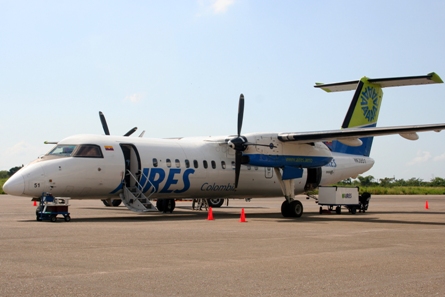Colombia's Aires is seeking to lease four Bombardier Dash 8 Q400s from 2010 as part of the next phase of its rapid expansion.
CEO Francisco Mendez says Aires is looking for 70-seat turboprops to operate alongside its newly acquired Boeing 737-700s on domestic trunk routes and to open thin short-haul international routes. Aires now operates a 737-700 fleet consisting of five aircraft that will grow to nine by year-end and a Dash 8 fleet consisting mainly of 37-seat Q200s that are used on regional routes.
Mendez says Aires' business plan envisions operating three aircraft types - 37-seat Dash 8 Q200s, 70-seat Dash 8 Q400s and 149-seat 737-700s. He says the business plan calls for initially operating a fleet of four Q400s and Aires is now talking to potential lessors.
"We're still trying to source them," Mendez says. "Some aircraft are available but it's difficult because of financing."
He says Aires is not interested in ordering new Q400s and is looking for relatively new aircraft which were manufactured in about 2007. Last November Mendez said Aires was planning to lease four ex-SAS Q400s from 2009 but that deal was never concluded and Mendez now says Aires prefers newer aircraft.
Mendez says Aires believes the Q400 is the perfect aircraft to operate some of the frequencies on the domestic trunk routes it has launched since placing its first 737-700 into service early this year.
Aires now competes on domestic trunk routes against Avianca and Aero Republica. Avianca serves these routes with a mix of Boeing MD-80s, Airbus A319/A320s and Fokker 100s with the smaller Fokker 100s typically operating off peak frequencies. Aero Republica is in the final stages of transitioning to an all-Embraer E-190 fleet.
Mendez claims the Q400 will give Aires a cost advantage over the Fokker 100 and E-190. He says Aires already has a cost advantage over its competitors with its 737-700s but the Q400 is better suited for certain frequencies, in particular off peak flights.
Mendez says Aires also plans to use Q400s to open new short-haul international routes to the Caribbean. Aires now uses the Q200 on flights to Aruba and Curacao and is looking to open several new Caribbean markets including Cuba and Jamaica. The new Caribbean flights will be operated with some of the four 737-700s to be added this year as well as the newly acquired Q400s.
As reported by ATI in June, Aires is also now in the process of transitioning its existing 15-aircraft Dash 8 fleet to focus on the -200 model. Aires previously operated a mix of -100s, -200s and -300s but Mendez says its last -100 was replaced with a -200 last month and its only remaining -300 will be replaced later this month with another -200.
 |
|---|
© Aires |
Mendez says Aires decided three years ago the -50-seater was too big for its regional routes and began the process of swapping its 50-seaters for -37-seaters. This process will finally be completed at the end of this month. Aires, which leases all of its aircraft, coordinated the swaps with various lessors.
The new Q400 fleet along with the four additional 737-700s that Aires plans to add over the next four months will allow Aires to continue expanding at a fast rate. In June Aires carried 122,000 domestic passengers, a 70% increase compared to June 2008. According to Colombian CAA data this gave Aires a 16% share of the Colombian domestic market, making it the second largest carrier after Avianca and just ahead of Aero Republica.
Mendez says Aires' domestic traffic reached about 160,000 passengers in July and is expected to reach 180,000 passengers in August, which will give it "close to 20% of the market". He says the carrier's load factor this month is averaging "close to 78%", up from 71% in June and about 60% in 2008.
The expansion also has driven rapid growth in Aires' revenues from $120 million last year to a projected $220-$230 million this year. Mendez expects revenues of almost $300 million in 2010 and says the privately-owned carrier, which turned a net profit of $3.5 million last year, should turn a similar profit in 2009 despite the start-up costs associated with the new 737 fleet.
Source: Air Transport Intelligence news
















